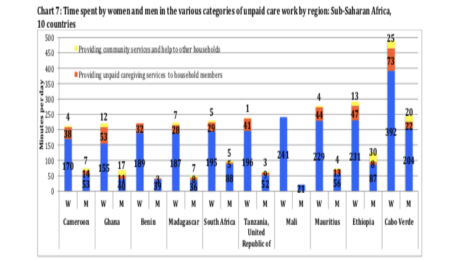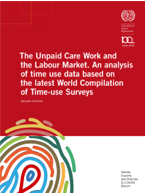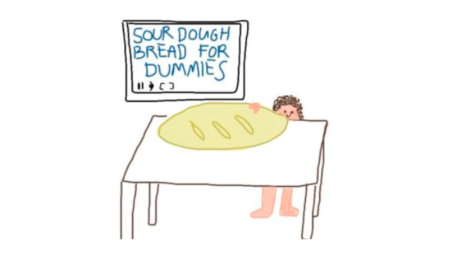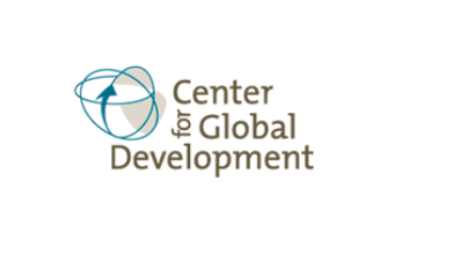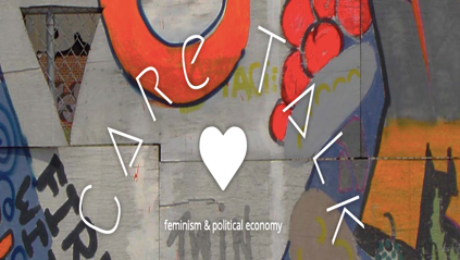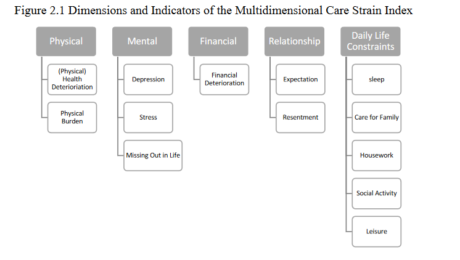Unpaid Work, Animated
About half of all the time devoted to work in the U.S. is devoted to unpaid work in the home. The Institute for New Economic Thinking has created an adorable animation of some comments I made in an interview with them on this topic a while back.
It’s quite a lot of fun, and basically accurate. Just don’t pay too much attention to the numbers they inserted into my discussion of two families, each with a market income of $50,000–the animation seems to imply that leisure should be assigned a monetary valuation–not something I advocate. Still, the main point comes through just fine: conventional measures provide a misleading picture of living standards.
The animation provides a great introduction to the topic for students, and you can find a more academic version of the basic argument in a short briefing paper I wrote for the Washington Center for Equitable Growth.
Original blog published on CARE TALK: FEMINIST AND POLITICAL ECONOMY on June 11, 2020. See here for the original posting.
Reposted with permission from Dr. Nancy Folbre from University of Massachusetts Amherst and an expert researcher for the Care Work and the Economy Project within the Rethinking Macroeconomics working group.
- Published in Expert Dialogues & Forums, Feminist Economics, Rethinking Macroeconomics
The Unpaid Care Work and the Labor Market. An analysis of time use data based on the latest World Compilation of Time-use Surveys
How much time do people spend on doing paid and unpaid care work? How do women and men spend their time differently on unpaid care work? Are there any differences in time use among the regions? How do socioeconomic factors influence people’s choices to do paid and unpaid care work?
Jacques Charmes addresses these questions in recent ILO report by providing a comprehensive overview of the extent, characteristics and historical trends of unpaid care work. The report is based on the analysis of the most recent time-use surveys carried out at the national level across the world, revealing the differences in time spent on unpaid care work between women and men and among people with different socioeconomic characteristics, such as geographical location, age and income groups, education level, marital status and the presence and age of children in the household. An insightful discussion of the concepts and methodological approaches underlying the analysis of time-use data is also offered.
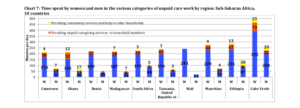
Chart 7 in the ILO Working Paper the Unpaid Care Work and the Labour Market. An analysis of time use data based on the latest World Compilation of Time-use Surveys illustrates the time spent by women and men in various categories of unpaid care work across Sub-Saharan African countries including Cameron, Ghana, Benin, Madagascar, South Africa, Tanzania, Mali, Mauritius, Ethiopia and Cabo Verde. As with the case around the world, women in Sub-Saharan African countries are providing significantly more unpaid care services in households and communities. Read the report to learn more about time-use analysis concepts and methodologies, gender variations in paid and unpaid work across the world and across various socio-economic levels:
International Labour Organization
Gender, Equality and Diversity & ILOAIDS Branch
This blog was authored by Shirin Arslan, Program Manager for the Care Work and the Economy Project
- Published in Child Care, elderly care, Policy Briefs & Reports
The Homemade Value-Added Stabilizer
“Shelter in place” mandates in the early stages of the U.S. Covid-19 pandemic required many people to stay home, cook their own meals, school their own children, and entertain themselves. Unpaid work served not only as a social safety net, but also as an automatic stabilizer. While it didn’t dampen fluctuations in official Gross Domestic Product, as did unemployment insurance, it clearly helped stabilize consumption.
Just imagine what would have happened if most people had not had refrigerators, stoves, and computers—or just read reports of the plight of homeless people.
By mid-March 2020, many states and localities shut down restaurants for any services other than take-out. Home-produced meals increased of necessity. Many such meals probably consisted of convenient processed foods that could be popped into a microwave oven, but a renaissance of home cooking also became apparent, along with reliance on long-lasting, easily stored items such as rice and beans. Analysis of Google Search terms showed a sharp spike in questions concerning food preparation and storage. As one newspaper put it, America began baking its heart out. Yeast suddenly became as hard to come by as toilet paper.
In 2018, according to the American Time Use Survey, adult civilian women spent an average of .8 hours a day, and their male counterparts .4 hours a day in meal preparation. How much more did they spend in the months of March and April, and what was the monetary value of this unpaid labor, based on what it would have cost them to hire someone to plan, cook, and clean up? How much did they save on eating-out?
Many childcare centers and schools were closed, leaving parents with responsibility for home-schooling, supervising children, and keeping them from going confinement-crazy. The American Time Use Survey averaged the amount of reported time that married mothers and fathers living with children under the age of 18 spent in primary activities of caring for and helping household children over the 2013-2017 period—an average of 2.6 hours per day for mothers not employed and 1.4 hours for fathers not employed.
Under sequestration, both active care and supervisory care (defined as the time in which an adult reported that a child under the age of 13 “in their care” ) ballooned. How much did these two forms of childcare increase? How much did households save on childcare costs?
Video streaming and gaming increased dramatically, especially during afternoon hours, and people began to rely more heavily on streaming for instruction and exercise as well as entertainment. So, while they spent less money (and less travel time) on entertainment away from home, they substituted forms of entertainment that were probably less expensive, on average. How much less expensive?
Between March and May, average household income plummeted as a result of job furloughs and unemployment. The increase in time devoted to household production buffered this loss to some extent—but without answers to the questions above, we can’t know how much. Most recent impromptu household surveys have focused primarily on women’s unpaid work relative to men’s—an important, but different topic.
For years, I have protested economists’ lack of interest in total consumption—defined as the sum of money expenditures and the consumption of home-produced services.
Let me will repeat one example that I have written about in more detail elsewhere: Compare two couples, each with two small children, each earning $50,000 after taxes. Conventional measures treat them as having exactly the same income. Yet one couple may include an adult earning $50,000 and a full-time homemaker/caregiver, while the other includes two adults earning $25,000 each and obviously has less time to devote to unpaid work. If we assigned any positive value to unpaid work, the first household would obviously be better off in terms of both income and consumption.
Market income is just not a very good indicator of total consumption among households with differing inputs of unpaid work. Also, the value of unpaid work is greater in households with more than one person, because of economies of scale in food preparation and childcare. Standard equivalence scales used to adjust household income for household size and composition completely ignore these issues.
Obviously, the additional unpaid work performed while sheltering in place was a source of great stress, especially for those simultaneously telecommuting, zooming, or otherwise trying to fulfill paid employment responsibilities at home. Yet, it’s hard to deny that this work also “added value,” enabling an important form of social provisioning.
The worst-case scenario for a household with children was almost certainly one in which all adults (e.g. mother and father) were essential workers, required to keep working (often at risk to their health) but unable to work from home. Federal and state agencies tried to provide “resources” for these workers, but no guarantees were forthcoming.
In many cases, one of the adults (probably the mother) was forced to quit or take a leave of absence from paid employment. While new federal legislation gives states flexibility to pay benefits where an individual leaves employment to care for a family member, not all states do so.
Such a policy is effectively a paid family leave—something that most states have shied away from for years, making this country an international outlier. The complexity of the new legislation, plus the difficulty of actually filing for and receiving unemployment benefits, has probably kept take-up pretty low even in states that allow this option.
Just one more reason to consider policies such as federal paid family and sick leaves and a universal basic income that could help the stabilizers known as households do their job.
Original blog published on CARE TALK: FEMINIST AND POLITICAL ECONOMY on May 19th, 2020. See here for the original posting.
Reposted with permission from Dr. Nancy Folbre from University of Massachusetts Amherst and an expert researcher for the Care Work and the Economy Project within the Rethinking Macroeconomics working group.
- Published in COVID 19, Time Use Survey, U.S., Unpaid Work
Playing the Long Game: How a Gender Lens Can Mitigate Harm Caused by Pandemics
When crisis hits, longer-term thinking can easily, and understandably, be cast as a distraction or a luxury—even when it relates to tackling critical issues like gender inequality, climate change, or extreme poverty.
Speaking personally, I’ve felt a bit silly trying to push forward projects that focus on gender lens investing or women’s economic empowerment in the last few weeks, given that my colleagues’ and collaborators’ attention, and frankly much of my own, lies elsewhere, and with something that seems much more pressing.
But for those of us who are in the position of privilege to continue thinking long term, it’s our responsibility to do so. Working towards structural changes that will take longer to come to fruition, especially those that relate to reducing global inequality, is the only way to radically decrease the extent of harm caused by moments of crisis, especially for vulnerable populations.
Dismantling unequal power structures, and in turn ensuring that every individual—regardless of gender, age, income level, national origin, and so on—has a safety net protecting them from vulnerability to health scares, income loss, and threats of increased violence, will allow us to focus on crisis without fearing fallout across every dimension of life.
In times of pandemic, the economically vulnerable cannot afford to stay home. Women in quarantine are facing increased risks of intimate partner violence. Girls staying home from school in some parts of the world may not have the opportunity to return. And none of this would be the case if we more effectively tackled the forms of inequality that underlie these realities. Then a virus could be a virus — assuredly deadly and destructive from a health perspective – but without inciting increased abuse, poverty, and lost prospects.
My colleague David Evans, drawing upon work by Claire Wenham, Julia Smith, and Rosemary Morgan in The Lancet, recently highlighted a range of problems stemming from the COVID-19 pandemic that disproportionately impact women and girls. In hopes of continuing to move the conversation forward, I propose some solutions to those problems here, and welcome others to add to this initial list. To be clear, these actions should not distract from immediate measures to address the pandemic. But we also can’t afford to risk forgetting about them when the focus on COVID-19 has faded; otherwise history is doomed to repeat itself.
1. Promote a Gender-Equal Health Workforce
Because the health workforce is disproportionately women (67%), women are at a higher risk of exposure to the virus within medical facilities.
More doctors worldwide are still men. But the vast majority of the global health workforce consists of nurses, community health workers, and others who are less highly compensated. All health workforce jobs need to become increasingly well-compensated, high-quality jobs. Not only will this incentivize men to seek these positions, destigmatizing their current positioning as “feminine” and dismantling occupational sex segregation within the healthcare sector, but it will also ensure that those on the frontlines of protecting populations from pandemics don’t also have to fear economic fallout on a day-to-day basis.
The number of women doctors is rising. Research from other sectors tells us what works to combat occupational sex segregation, including men acting as mentors supporting women to “cross over” into higher-paying occupations. These efforts will have to be paired with those that increase the perceived (and actual) value of work in sectors, including nursing and other frontline health work, where women dominate. More research is needed on this front, both on what works to incentivize men to take up traditionally “feminine” roles and how to avoid unintended displacement of women from those occupations.
2. Protect (and Expand) Existing Health Resources
With all hands on deck to fight COVID-19, particular groups of women and girls face other health risks.
Health facilities should not have to choose between providing lifesaving care in the face of pandemics and continuing to provide support for those in need in other areas, including pregnant women, adolescent girls (who have the highest prevalence of HIV infection, and in need of life-saving medication to keep their immune systems strong), and all women and girls in need of contraceptive access.
Increased investments in health are needed to ensure critical day-to-day care is not compromised during times of crisis. Establishing a Global Health Security Challenge Fund would help ensure countries are prepared to balance day-to-day needs with additional burdens in the face of pandemic, and evidence-based prioritization strategies are needed for when resources cannot be expanded.
3. Reduce and Redistribute Unpaid Care Work Burdens
As schools close and people fall ill, women and girls will assume increased unpaid care work burdens.
Under business-as-usual scenarios, women and girls do more than their fair share of unpaid care work, which limits their educational attainment, workforce participation and advancement, and leisure time. To lessen these burdens in times of crisis and more generally, we need increased investments in child and elder care, and in the poorest countries, gender-responsive energy, water, and sanitation infrastructure that would reduce the time women and girls must spend collecting water and fuel, as well as cooking and cleaning. We also need shifts in household norms that mean men assume more unpaid care responsibilities. Initiatives focused on promoting women’s economic empowerment, such as 2X Challenge and the Women’s Global Development and Prosperity (W-GDP) initiative, as well broader investments in gender equality and economic growth, must prioritize reducing and redistributing women and girls’ unpaid care work.
4. Address Gender-Based Violence
With quarantine measures imposed and stress heightened, women are at increased risk of violence committed by their partners and family members, and essential support services are absent.
Early reports suggest that gender-based violence rates are increasing in light of COVID-19 quarantining, consistent with evidence documenting increased violence in other crisis settings. Gender-based violence needs to be elevated as its own public health crisis, and resourced accordingly.
We’re far from meeting this objective, considering that all OECD donors combined allocated less than $200 million to addressing violence against women according to 2016-17 data, and over half of this financing came from just three countries (Australia, Canada, and Norway). Increased resources should target evidence-based approaches, such as Promundo’s MenCare program.
In pandemic contexts, preparations for social distancing should include considerations of how individuals will be able to access social services when faced with violence in their households. The World Bank has taken a step in the right direction in positioning interpersonal and gender-based violence as priorities to address in its new Fragility, Conflict, and Violence Strategy, though time will tell how the bank and other donor institutions finance this priority.
5. Guarantee Girls’ Education
With schools closing as part of social distancing measures, girls who already face pressure to drop out of school may not return.
Even absent crisis, tens of millions of girls globally face pressures to drop out of school to care for siblings and do other unpaid domestic work, contribute to supporting their households financially, and/or marry and have children when they are still children themselves. These pressures may be heightened due to interruptions in their education, as observed when Ebola hit West Africa. School closures, especially those impacting adolescent girls, should be weighed against longer-term risks related to girls’ school drop-out and limited school-to-work transition prospects as a result. Where possible, efforts should be made to incentivize parents to allow their children to return to school and to ensure consistent access to sexual and reproductive health services in the interim, as unintended pregnancy is cited as a reason for girls’ failure to return to school.
6. Promote Women’s Economic Opportunities
Across the globe, women are more likely to work jobs that are low-paid, informal, and lacking in benefits.
In large part due to the disproportionate unpaid care work women take on, they are less likely to be employed full-time, in the formal workforce, or in jobs that provide paid sick leave, unemployment insurance, and other protections.
We must continue to invest in evidence-based programs and policies that improve women’s economic opportunities and support organizations such as the Self-Employed Women’s Association and Women in Informal Employment: Globalizing and Organizing—organizations that are well-positioned to provide and advocate for dignified work.
Cash transfers should be considered as a means of ensuring a social safety net for those most in need. Critical to transfers’ success will be (1) ensuring that delivery mechanisms (through digital technology or otherwise) are properly designed and implemented and (2) that those in need, including low-income populations and workers vulnerable to economic backslides because of the virus, are prioritized.
7. Ensure Women’s Representation in Decision-Making and Critical Research
Women are not equally represented in decision-making roles responding to the COVID-19 pandemic.
The White House Coronavirus Task Force is over 90 percent men, and the team Prime Minister Johnson just assembled to lead the United Kingdom’s COVID-19 response is all men. As in the contexts of peace and security, international trade, and climate change, an exclusionary approach to decision-making will yield inferior decisions: those that don’t account for the needs and constraints of populations absent from the table.
Going forward, decision-making teams should be equally representative of men and women, and also prioritize other forms of inclusion, such as those based on race and ethnicity, as called for by Women in Global Health’s Operation 50/50 campaign.
Women must also be equally represented in clinical trials as biomedical treatments and other interventions are developed. As my colleague Carleigh Krubiner has noted speaking to the context of Ebola, women who are pregnant or breastfeeding are typically excluded from experimental studies, and in some high-fertility contexts, this means up to 80 percent of reproductive age women are virtually invisible in trial samples. Lack of representation means a lack of essential data on the types of prevention methods, treatments, and other interventions that work for women, risking higher fatality rates and other complications.
Times of crisis magnify the cracks in our systems and highlight disproportionate risks to the most vulnerable among us. COVID-19’s impacts, those already felt as well as those still anticipated, should serve as a wake-up call. They should spur action to address underlying inequalities, including those that disadvantage women and girls worldwide and make the consequences of a pandemic even worse than they would otherwise be. Increased prioritization of women and girls’ health, education, economic opportunity, safety, and decision-making power can help create a world where no one falls through the cracks. Decision-makers should realize this is inextricably linked to today’s pandemic response.
Contributed by Megan O’Donnell Assistant Director, Gender Program and Senior Policy Analyst at Center for Global Development
Original blog published on Center for Global Development website March 18, 2020, see here for the original post
Reposted with permission from Megan O’Donnell Assistant Director, Gender Program and Senior Policy Analyst at Center for Global Development
- Published in COVID 19, Gender-Equal Economy, Healthcare
Are We All Care Workers Now?
Who, exactly, are care workers, other than the people we need most right now, as the covid-19 pandemic overlays the division of labor with a new division of risk?
I’ve long been an advocate of using the term “care worker” rather than “caregiver” even though the work can be and often is, at least in part, a gift. Because care–whether performed for pay, or not–is at the crux of any sustainable economic system. All work depends on the successful production and maintenance of workers themselves. Yet because this very notion of care-as-work is relatively new, there is little agreement on its exact boundaries.
When I first started pursuing this issue with Paula England, we emphasized hands-on or face-to-face work that develops the capabilities of the care recipient, an essential aspect of the services that health care providers, workers, child care and elder care workers provide. This emphasis could be translated into a specific list of Census-designated occupations, grounding empirical research on the relative pay of care workers that has revealed significant pay penalties for both women and men in such occupations, controlling for many other variables such as education, experience, and unionization.
I liked this broad definition because it spanned paid and unpaid work, low-wage and relatively high-wage occupations, women and men, creating potential for new political alliances. Sociologists initially embraced the definition with some enthusiasm. Not so, economists, and Robert Solow, who attended some meetings of the Russell Sage Foundation Network on Care Work, pushed us for more specificity.
I felt some affinity with Kenneth Arrow’s insistence on the limits of markets and with efficiency-wage theories pointing to the difficulty of monitoring worker productivity, so added another twist to the definition: work in which concern for the welfare of the care recipient is likely to affect the quality of the service provided. In other words, work not performed entirely for money, akin to what some economists have termed “public service motivation” but more…personal.
Still not quite right. Sociologist Mignon Duffy has argued eloquently in Making Care Count that this definition privileges what she calls “nurturant care,” deflecting attention from the drudgery of menial care tasks–the emptying of bed pans, cleaning of toilets, and mopping of floors often performed by the most disempowered members of society. “Dirty” work itself is devalued. Duffy’s work has nudged me to focus more on industry–the economic consequences, for instance, of being employed in health care, education, or social services, regardless of occupation.
The pandemic, however, has pushed me over a cliff, because it is redefining the meaning of “dirty” work–now, any work that increases the risk of exposure to a potentially deadly virus: not just health care, child care, and elder care and unpaid care for family members, but also food services, package delivery, police protection, home repair services, garbage collection…the list goes on. We rely heavily on the motivations of such workers to minimize our own–as well as their own–chances of infection.
The entire sequestration/shelter-in-place/social distancing strategy relies heavily on good will and voluntary compliance. The very invisibility of covid-19 blurs the boundaries between love and money, us and them. The healthy now may later be sick, the sick now may later be dead. When risk is shared, the overlaps between solidarity and self-interest expand.
Yet so many boundaries, however blurry, remain in place. Whether because of who they are or what they do, some workers face much greater risks than others. It’s not enough to cheer them on, to offer them applause or a bit of extra cash.
If we are all care workers now we should do everything in our power to protect our own.
Original blog published on CARE TALK: FEMINIST AND POLITICAL ECONOMY on April 4, 2020. See https://blogs.umass.edu/folbre/
Reposted with permission from Dr. Nancy Folbre from University of Massechusetts Amherst and an expert researcher for the Care Work and the Economy Project
- Published in Child Care, COVID 19, elderly care
Measuring the Overall Strain of Caregiving: A Multidimensional Approach
Providing care for others, especially for the frail elderly and young children, is one of the most important forms of human work that sustains our existence. However, caregiving is also often challenging and strenuous. Many informal caregivers are known to suffer negative physical, emotional, and social outcomes, and are at risk of losing their own health and well-being. Fengler and Goodrich, for example, refer to the wives of frail elderly men as ‘the hidden patient,’ warning the negative consequences of caregiving on informal caregivers. Since the 1980s, several instruments have been developed to measure the strain of caregiving among informal caregivers. Some measurements such as the Zarit Burden Interview and the Caregiver Strain Index have been applied more widely, while other measurements have been used for more specific groups of caregivers (e.g., who takes care of the elderly with cancer). Although these measures provide valuable information on various dimensions of caregiver strain, they are not sufficient to assess the overall level of strain experienced by caregivers. In most cases, these measurements consist of a list of questions or statements about the caregiver’s burden; the sum of the answers is then used to indicate the level of burden/strain experienced by the caregiver. Although useful, a simple non-weighted sum of answers may not be an accurate representation of the overall strain. For instance, two groups of caregivers may have the same average total strain score, but one group may consist of all caregivers who suffer strain in some statements, while the other group may have half of the care givers who suffer strain in all statements and the other half who do not suffer strain at all. While the marginal distribution may be the same, the joint distribution may not, and this has an important policy implication.
Adapting the Alkire-Foster method developed to measure multidimensional poverty, Jun et al (2019) propose a threshold-based approach to measuring overall caregiving strain that accounts for the multidimensionality of the caregiving experience. The approach is based on the premise that as in the case of poverty, the negative consequences of multiple strains attached to caregiving would be greater than the sum of their individual effects. The authors first identify the dimensions and indicators that are known to be important consequences of caregiving, such as physical, psychological, financial and relational strains, and daily life constraints. They then count the overlapping strains a care giver experiences under different indicators of caregiver strain. Next, they identify caregivers who are experiencing strains above a specific cut-off point as multi-dimensionally strained. This measure is tested using the data from the newly collected Survey of Eldercare and Childcare in Korea 2018, exploring whether receiving support, help and appreciation may be associated with reduced chance of being multi-dimensionally strained. By providing an overall measurement that identifies caregivers with multiple strains, the authors examine 1) which group of caregivers are more likely to be at risk; 2) which dimensions do most caregivers suffer strain; and 3) what may be potential buffers for caregiving strain.
This paper will be available December 2019
This blog was authored by Jiweon Jun, Ki-Soo Eun and Ito Peng
- Published in South Korea, Understanding and Measuring Care
- 1
- 2


